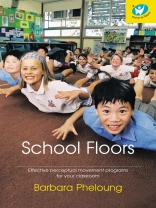School Floors gives information about things that can be done after the Move to Learn movement program as well as advice about how to get the program into schools. There are chapters on diet, nutrition, food additives, allergies, sound therapy, auditory processing, the effect of retained primitive reflexes, playground management and improving social interaction.
Particularly helpful are a quick functional vision screening test, a ‘ready for school?’ test and a ‘what to look for before the third birthday’ chapter.
There are exciting contributions by many leading educators, therapists and specialists in the field of learning difficulties including:
Veronica Steer, Dr Marilyn Dyson, Chris Chapparo, Margaret Greville, Pye Twaddell, Sue Larter, Sue Dengate, Jacqueline Lee, Sue Mackay, Julia Dive, Sue Mackay, Michelle Learmouth, Rachel Fisher, Winsome Richards, Mike Almond & Carol Hewatt.There are chapters explaining the importance of diet and dealing with sound therapy and auditory processing, as well as a section dealing with the effect of retained primitive reflexes & allergies on learning by Occupational Therapist, Veronica Steer and Dr Marilyn Dyson.
Table of Content
Chapter 1 – My Journey
Chapter 2 – The Pyramid of Learning.
Chapter 3 – How movement could benefit those with Learning Difficulties – Veronica Steer, Occupational Therapist, Sound Therapist and Kinesiologist.
Chapter 4 – The signs and effects of oversensitivity to certain foods and food additives and the difficulties of changing what we eat. – Dr. Marilyn Dyson.
Chapter 5 – This chapter provides a description of a basic movement program that helps to prepare children for classroom achievement. It contains advice on how to introduce and implement the program and an explanation of Primitive Reflexes.
Chapter 6 – The New Pioneers
6a – From getting to the roots of her son’s problem to those of many preschoolers – Winsome Richards
6b – Commonwealth Literacy Program – Margaret Greville
6c – A Teacher’s Aide ends up teaching Teachers – Julia Dive
6d – Enhancing Learning through movement – Sue Mackay
6e – Move to Learn in the classroom – Michelle Learmouth
6f – A Remedial Teacher Converts her School to a Holistic Movement Based Approach to LD – Carol Hewatt
6g – Mental diseases and Learning Difficulties are both neurologically based – Rachel Fisher
Chapter 7 – Learning Difficulty Support Groups and how to start one.
Chapter 8 – Research
Christine Chapparo shares of how she brought Occupational Therapy into 2 schools.
Chapter 9 – Additional Resources
9a – Calming overactive and oversensitive children in the classroom – Veronica Steer.
9b – Sound Therapy and Auditory Processing – Veronica Steer
9c – Healing the Hurts
Various healing therapies to relieve stress caused by neurological, emotional and environmental imbalances.
9d – Food Journals
Michelle Learmouth, a classroom Teacher, shares examples of student journals.
9e – Getting Good Enough to Get on a Team
Additional movement activities to build skills for ball catching and throwing, bat and ball activities, handwriting and some social skills – Veronica Steer.
9f – How to Survive the Playground
Jacqueline Lee, an acting Headmistress, shares playground management techniques and suggestions of safe equipment.
9g – Parental Help with Movement Program
A Teacher, Sue Mc Kay, shares the form she designed to ask for the help of parents with the movement program in the school.
9h – Applying for Funding for Early Assessment
Winsome Richards shares the letter she wrote for funding support for school entry assessment at South Kalgoorlie, Australia, Pre-Primary, 1998.
9i – Australian Dirty Dozen Additives
Sue Dengate, an Australian authority on nutrition and food intolerance, lists the worst 12 additives in our processed foods – as of December 2005.
9j – Quick Functional Vision Screening
Sue Larter, Behavioural Optometrist, explains 2 quick tests which can alert to possible visual immaturities.
9k – Ready for School?
Dr. Pye Twaddell, educator, describes her standardized Australian school entry test that can be done by any Teacher.
9l – Signs to Look for Before the Third Birthday
Simple things that parents can identify as immature development and then correct quickly.
9m – Nutrition and Biochemistry
Nutrition and food intolerance – Dr Marilyn Dyson
9n – The Green Shed Girls Learn about Social Interaction
Julia Dive, a teacher’s aide, shares tips for improving self confidence and social skills of LD students.
9o – Drumming
Mike Almond, percussionist, shares an easy way for teachers and students to try drumming without the need for drums or much musical experience, only a sense of adventure.
9p – Movement and the Use of 3 dimensional Objects
Helps students to understand number work more easily.
About the author
Barbara Pheloung, B.A., Dip.Ed.(Spec.Ed.), was a resource teacher, born in Canada, who spent over 35 years specialising in working in the field of special education in Australia.In 1987 she set up a specialised treatment centre in Manly, Australia, known as ‘The Beach House’. This was a private centre for those with Learning Difficulties and Hyperactivity in which Teachers, Physiotherapists, Occupational Therapists and a Physical Education Teacher worked together sharing their expertise. Barbara’s team proved that by working together, starting with the professional who met the most basic needs of a particular child, results could be quick and permanent. The success of The Beach House also demonstrated that similar centres could be set up in any community and with a minimum of financial support.
Barbara went on to become a pioneer in the field of learning difficulties; authoring four books, producing two educational DVDs and working with thousands of students, parents and teachers across the world. She and her associates refined and perfected a sequential movement program that can be done with an individual, a small group or with a whole class and requires little in terms of training or equipment. The movement sequences seem to act as a ‘neurological kick-start’, helping children to reach learning readiness and removing the obstacles that had blocked them in the past.
In 2004 Barbara was nominated for Australian of the Year.












